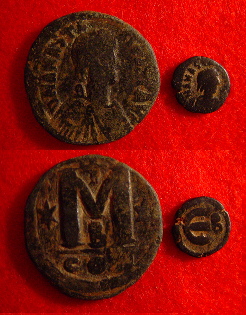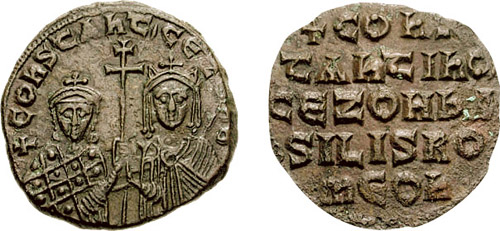Follaro on:
[Wikipedia]
[Google]
[Amazon]
 The follis (plural ''folles''; it, follaro, ar, فلس, Fels) was a type of coin in the
The follis (plural ''folles''; it, follaro, ar, فلس, Fels) was a type of coin in the
 In the past, the term ''follis'' was used to describe a large bronze Roman
In the past, the term ''follis'' was used to describe a large bronze Roman

 The follis was reintroduced as a large bronze coin (40 nummi) in 498, with the coinage reform of Anastasius, which included a series of bronze denominations with their values marked in
The follis was reintroduced as a large bronze coin (40 nummi) in 498, with the coinage reform of Anastasius, which included a series of bronze denominations with their values marked in National Bank of the Republic of Macedonia
Macedonian currency. Banknotes in circulation
50 Denars
. – accessed on 30 March 2009. The
A close look at a follis by Doug Smith
Follis Coin Catalog information and details
{{Byzantine coinage Coins of ancient Rome Numismatics Coins of the Byzantine Empire
 The follis (plural ''folles''; it, follaro, ar, فلس, Fels) was a type of coin in the
The follis (plural ''folles''; it, follaro, ar, فلس, Fels) was a type of coin in the Roman
Roman or Romans most often refers to:
*Rome, the capital city of Italy
*Ancient Rome, Roman civilization from 8th century BC to 5th century AD
*Roman people, the people of ancient Rome
*'' Epistle to the Romans'', shortened to ''Romans'', a lette ...
and Byzantine
The Byzantine Empire, also referred to as the Eastern Roman Empire or Byzantium, was the continuation of the Roman Empire primarily in its eastern provinces during Late Antiquity and the Middle Ages, when its capital city was Constantinopl ...
traditions.
Roman coin
 In the past, the term ''follis'' was used to describe a large bronze Roman
In the past, the term ''follis'' was used to describe a large bronze Roman coin
A coin is a small, flat (usually depending on the country or value), round piece of metal or plastic used primarily as a medium of exchange or legal tender. They are standardized in weight, and produced in large quantities at a mint in order t ...
introduced in about 294 (the actual name of this coin is unknown)
at the time of the coinage reform of Diocletian. It weighed about 10 grams and was about 4% silver, mostly as a thin layer on the surface. However, later studies have shown that this is wrong, and that this coin may have been known as a "nummus
''Nummus'' ( el, νοῦμμος, ''noummos''), plural ''nummi'' () is a Latin term meaning "coin", but used technically by modern writers for a range of low-value copper coins issued by the Roman and Byzantine empires during Late Antiquity. It ...
". The word ''follis'' means bag (usually made of leather) in Latin, and there is evidence that this term was used in antiquity for a sealed bag containing a specific amount of coinage. It has also been suggested that the coin was named Follis because of the ancient Greek word "φολίς" meaning a thin layer of metal (''cf.'' Latin '' folium'', "leaf
A leaf ( : leaves) is any of the principal appendages of a vascular plant stem, usually borne laterally aboveground and specialized for photosynthesis. Leaves are collectively called foliage, as in "autumn foliage", while the leaves, ste ...
") which covers the surface of various objects, since originally, this coin had a thin layer of silver on top. The 'follis' of Diocletian, despite efforts to enforce prices with the Edict on Maximum Prices
The Edict on Maximum Prices (Latin: ''Edictum de Pretiis Rerum Venalium'', "Edict Concerning the Sale Price of Goods"; also known as the Edict on Prices or the Edict of Diocletian) was issued in 301 AD by Diocletian. The document denounces mon ...
(301), was revalued and reduced as time passed. By the time of Constantine the Great
Constantine I ( , ; la, Flavius Valerius Constantinus, ; ; 27 February 22 May 337), also known as Constantine the Great, was Roman emperor from AD 306 to 337, the first one to convert to Christianity. Born in Naissus, Dacia Mediterran ...
, it was smaller and barely contained any silver. A series of Constantinian bronzes
In numismatics, the term Constantinian bronzes denotes the series of bronze coins issued in the Roman Empire in the middle of the 4th century. The specific denominations are unclear and debated by historians and numismatists. They are referred t ...
was introduced in the mid-4th century, although the specific denominations are unclear and debated by historians and numismatists. They are referred to as AE1, AE2, AE3 and AE4, with the former being the largest (near 27 mm) and the latter the smallest (averaging 15 mm) in diameter. Namely:
Fourth century ''folles'' represent the largest category of coin finds in the United Kingdom.
Byzantine coin

 The follis was reintroduced as a large bronze coin (40 nummi) in 498, with the coinage reform of Anastasius, which included a series of bronze denominations with their values marked in
The follis was reintroduced as a large bronze coin (40 nummi) in 498, with the coinage reform of Anastasius, which included a series of bronze denominations with their values marked in Greek numeral
Greek numerals, also known as Ionic, Ionian, Milesian, or Alexandrian numerals, are a system of writing numbers using the letters of the Greek alphabet. In modern Greece, they are still used for ordinal numbers and in contexts similar to those ...
s. A 40 nummi coin of Anastasius is depicted on the obverse
Obverse and its opposite, reverse, refer to the two flat faces of coins and some other two-sided objects, including paper money, flags, seals, medals, drawings, old master prints and other works of art, and printed fabrics. In this usage, ...
of the North Macedonian 50 denars banknote, issued in 1996.Macedonian currency. Banknotes in circulation
50 Denars
. – accessed on 30 March 2009. The
fals
The fals ( ar, فلس, fals, plural ''fulus'') was a medieval copper coin first produced by the Umayyad caliphate (661–750) beginning in the late 7th century. The name of the coin is derived from the '' follis'', a Roman and later Byzantine ...
(a corruption of ''follis'') was a bronze coin issued by the Umayyad
The Umayyad Caliphate (661–750 CE; , ; ar, ٱلْخِلَافَة ٱلْأُمَوِيَّة, al-Khilāfah al-ʾUmawīyah) was the second of the four major caliphates established after the death of Muhammad. The caliphate was ruled by the ...
and Abbasid
The Abbasid Caliphate ( or ; ar, الْخِلَافَةُ الْعَبَّاسِيَّة, ') was the third caliphate to succeed the Islamic prophet Muhammad. It was founded by a dynasty descended from Muhammad's uncle, Abbas ibn Abdul-Muttalib ...
caliphate
A caliphate or khilāfah ( ar, خِلَافَة, ) is an institution or public office under the leadership of an Islamic steward with the title of caliph (; ar, خَلِيفَة , ), a person considered a political-religious successor to th ...
s beginning in the late 8th century, initially as imitations of the Byzantine follis.
See also
*Trifollaro
The ''trifollaro'' or ''trifollaris'' was a copper coin minted in southern Italy under the Normans. It was worth 120 ''nummi'' or 3 ''folles''. The name ''trifollaro'', used by scholars, was coined by the Italian numismatist Rodolfo Spahr. Contemp ...
, a medieval coin worth 3 ''folles''
*Fals
The fals ( ar, فلس, fals, plural ''fulus'') was a medieval copper coin first produced by the Umayyad caliphate (661–750) beginning in the late 7th century. The name of the coin is derived from the '' follis'', a Roman and later Byzantine ...
, Copper coin of Umayyads and Abbasids
*Falus
The falus was a bronze/copper currency of Morocco.
Minted between 1672–1901, denominations of , , 1, 2, 3, 4, 6 and 8 falus are recorded in the Standard Catalogue.
Identification
They are typically denominated by size rather than by inscrip ...
, former Moroccan coin
*Fils
Fils or FILS may refer to:
People
* Anton Fils (1733–1760), German composer
* Arthur Fils (born 2004), French tennis player
* Pascal Fils (born 1984), Canadian football player
Other uses
* Fils (currency), a subdivision of currency used in ...
, modern subdivision of certain Arab currencies
References
Sources
* * *External links
A close look at a follis by Doug Smith
Follis Coin Catalog information and details
{{Byzantine coinage Coins of ancient Rome Numismatics Coins of the Byzantine Empire